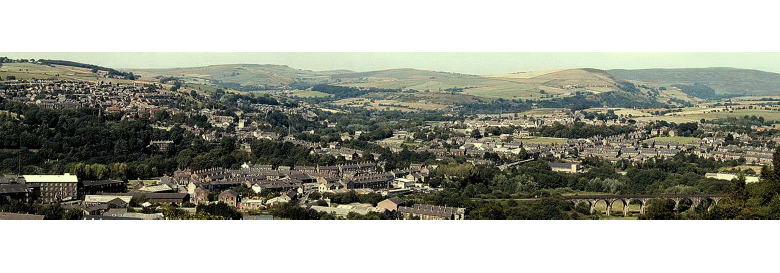AIR RAID
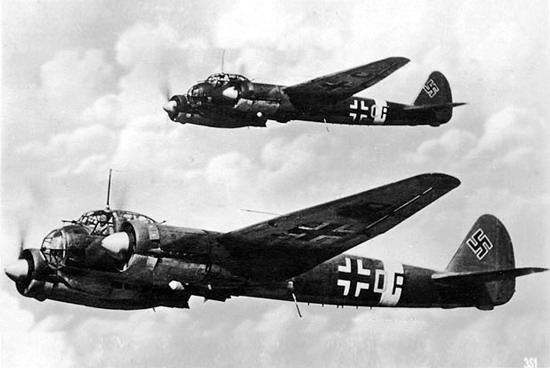
The details of the Air Raid of the 3rd of July 1942 are well known:-
At 8-00 p.m. two German JU 88s swept low up the valley from the direction of Manchester. No Air Raid warning was given, and amongst those who noticed the low approaching aircraft there was confusion as to the identity of the planes. Within seconds the craft had split one launching an ineffective attack on the railway viaduct. The other attacking the Gasholder, in Mousley Bottom without success.
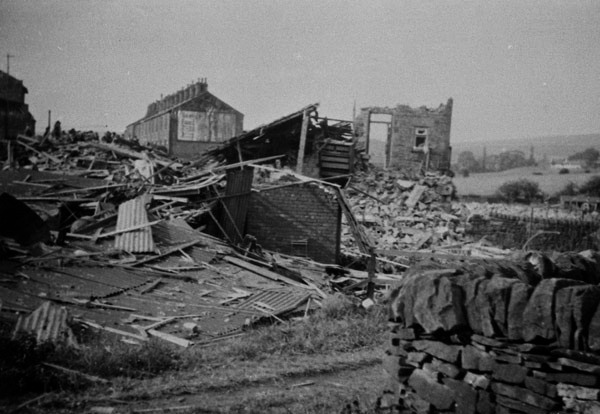 Though Lowe's Mill, the railway station and signal box all had their windows blown out. This aircraft flew on to Low Leighton at roof top height, spraying machine gun bullets into the streets, and amongst a boys cricket match on the Church Road field as it passed. At Low Leighton another bomb was dropped. This demolished two houses and the Methodist Chapel, which stood where the modern Fire Station stands today. There were two fatal casualties, Joan Handford a ten year old and Daniel McKellar, a man of 79, who was wounded in the blast and died the following day. Though Lowe's Mill, the railway station and signal box all had their windows blown out. This aircraft flew on to Low Leighton at roof top height, spraying machine gun bullets into the streets, and amongst a boys cricket match on the Church Road field as it passed. At Low Leighton another bomb was dropped. This demolished two houses and the Methodist Chapel, which stood where the modern Fire Station stands today. There were two fatal casualties, Joan Handford a ten year old and Daniel McKellar, a man of 79, who was wounded in the blast and died the following day.
The two aircraft flew on up the Sett valley where the people of Hayfield were also unaware of their approach. The paper of the time carried a witness account of the bombing of Hayfield and its aftermath "The raid came with amazing suddenness. I was in the house when I heard an explosion in the distance which sounded very much like thunder. But it was followed by the crackle of machine gun fire. Others, I found afterwards, had heard the same noises and did not know for the moment what to make of them. Some were in their gardens, others were taking a walk, some were playing whist at a drive held for the RAF Benevolent fund.
I looked to where the machine was, but I heard it flying over the roof of the house with terrific noise. Before I could get to the door it had gone. Then I heard another explosion and saw a cloud of smoke rising such as I had seen at A.R.P. exercises.... Everybody knew that a bomb had dropped.
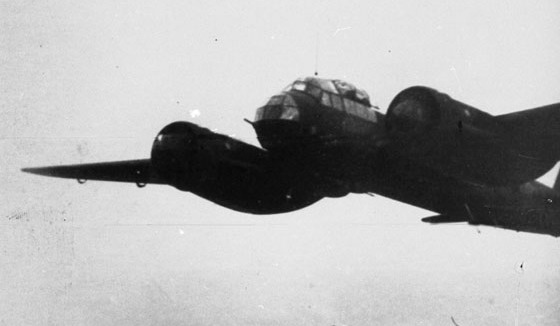
There was no need to call out the civil defence services. Members of the services heard the bomb, and they rushed to the scene and were soon busy. Before it was really known what had happened the rescue squad were at work and the fire pumps were busy, although there was little fire evident at the time. Incendiary bombs had been dropped near by where children were playing on the recreation ground. The boys got a new sport collecting the spent incendiaries.
The three cottages which had been hit were an appalling sight. They had gone down like a box of cards under the powerful explosion......what struck one most was the entire absence of panic or hysteria. It was the first experience of bombing and gun firing from the air that many present had known. But they knew what to do and they did it. The Home Guard and the special police were there, as well as the civil defence services. The first person I had seen after the second explosion was the village constable rushing to the scene on his bicycle. Many of the men on the job had rushed there without donning their uniform, and had only their helmets for protection. They worked with amazing strength and speed, and yet with extreme care, in case any under that huge heap of debris should still be alive. Happily some were and they were rescued."
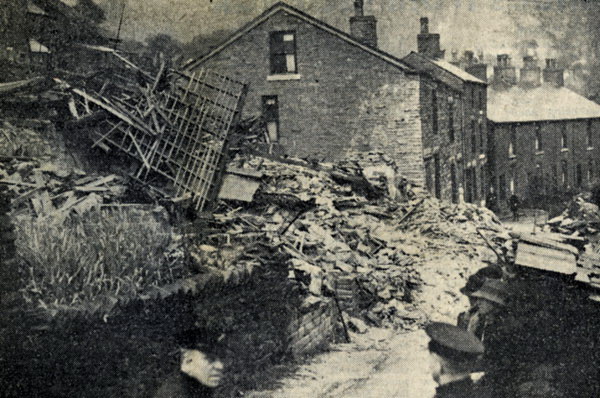
The two German raiders were eventually intercepted and shot down in Lincolnshire, where the crew of one aircraft perished.
The names of the two casualties in New Mills and the six in Hayfield are recorded amongst the war dead on the respective memorials.
THE FOLLOWING HAYFIELD CIVILIANS WERE KILLED BY ENEMY ACTION ON THE 3RD JULY, 1942
ALBERT GIBSON, AGE 61. OF SETT VIEW, SPRING VALE ROAD, HAYFIELD; HUSBAND OF EDITH GIBSON. A VETERAN OF THE GREAT WAR.
EDITH GIBSON. AGE 49. OF SETT VIEW, SPRING VALE ROAD.
GLADYS MAY GIBSON. AGE 19. OF SETT VIEW, SPRING VALE ROAD. DAUGHTER OF THE ABOVE COUPLE.
MARGARET JANE GIBSON. AGE 21. OF SETT VIEW, SPRING VALE ROAD. DAUGHTER OF THE ABOVE COUPLE.
HANNAH ROBINSON. AGE 47. DAUGHTER OF MR AND MRS CHARLES COOPER, OF LITTLE HAYFIELD. WIFE OF LIONEL HALL ROBINSON, OF NEWHAVEN, LEA ROAD, HAYFIELD. KILLED AT SETT VIEW, SPRING VALE ROAD.
FREDA THORPE. AGE 10. DAUGHTER OF MR AND MRS THORPE OF 78 MOUNT ROAD, BELLE VUE. AN EVACUEE KILLED AT SPRING VALE ROAD, HAYFIELD.
There were of course many witnesses to the events of that terrible day, but one of the few to have recorded their memories is Marjorie Hyde (nee Whiteford) of Newtown. Marjorie has been kind enough to allow me to reproduce her memories here:-
The New Mills and Hayfield Air Raid of July 1942 – by Marjorie Hyde
The 3rd of July 1942 was two days after my 14th birthday. At that time, I lived with my parents, Joseph and Hannah Whiteford, on Buxton Road, Newtown. On the evening of the 3rd I was with some friends on the hill behind the houses on Buxton Road which was supposed to be called Ollerenshaw Brow but always known as ‘Uncha Brew’. There were several of us, boys and girls, but I can’t remember now exactly who was there: my special friends at the time were Joan Rowley and Vera Poole, who both lived on Buxton Road, but I don’t think either of them was, and the only one I can be certain was there was Leslie Kirk. We were near the top of the hill, looking out over the valley, and there were some other lads playing cricket on the level area a bit further down.
Suddenly we heard the sound of aircraft engines, from the direction of Manchester, and two planes appeared, very low, flying along the valley towards New Mills. Of course the boys knew about identifying planes, and as they came closer Leslie suddenly shouted, ‘They’re Germans!’
Obviously we set off down the hill towards Buxton Road as fast as we could, and the cricketers too. When I got to our house, my mother was just coming out of the front gate. My father was an ARP warden, and had already gone out. By this time we’d heard the sound of explosions and machine-gun fire, from the direction of New Mills, and my mother was going down to Wood Street where her parents, George and Sarah Wild, lived, and also my aunt Eliza, my mother’s sister, to see if they were all right.
I went with her, first to my aunt’s house at number 1 Wood Street, and then, finding that she was all right, to my grandparents’ at number 15. They were all right too, but my grandfather had had a narrow escape. Presumably hearing the bombs, he had gone to look out of the front window to see if he could see anything. He couldn’t, and stepped back into the room a little: no sooner had he done so when there was another explosion (I believe this was from the bombs at Lowleighton), and the window blew in. It was not till later of course that we heard about the destruction and loss of lives at Lowleighton and Hayfield.
There is a little personal postscript to the story. Your article on the air raid mentions that machine-gun fire stopped a boys’ cricket match on the ground at Church Road. It must have been between New Mills and Birch Vale, as one lad who was playing was Learoy Hyde, from near the Vine Tavern at Birch Vale. I didn’t know him at the time, but we later met, and he became my husband.
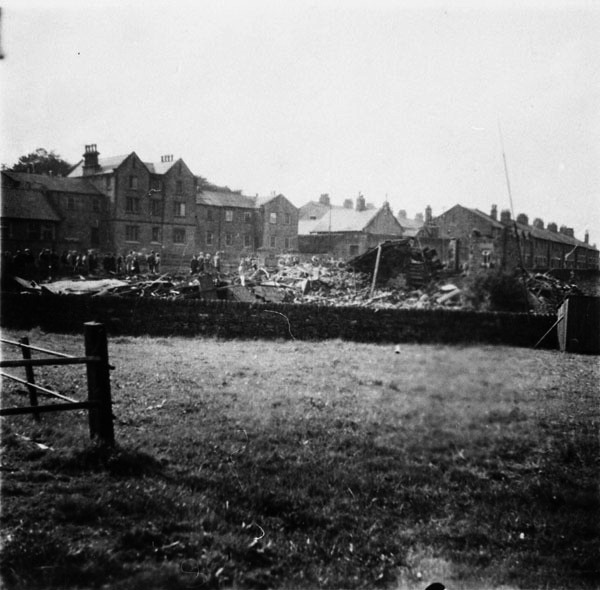
There had been several bombs and flares dropped in the area prior to the raid of July 1942. Mostly these had fallen on high ground and farmland and though the noise and flashes of the explosion had sometimes caused concern they had caused no injury or damage to property. Except that is for the Rowarth "raid" of the 31st of August, 1940. This was almost certainly an indiscriminate and untargeted dropping of the bomb load of one or more German aircraft. It is most probable that the aircraft involved had over flown their intended target at Manchester and decided to drop their bomb load before reaching the high ground of the Peak District.
At around 10-45 p.m. that night a Mr Jos Devlin, Rowarth Postmaster was making his way home down Hollinsmoor Road, "...there was an indescribable noise, as if the whole earth was just one fearful whizz. Instictively I threw myself prone on the ground face downward. Then came a terrible explosion which lifted me inches from the ground, although I was perfectly prone, and it nearly took the breath out of my body. It was a high explosive bomb, and I learned later that the glass had been smashed in some houses a considerable distance from where I was , but that nobody had been hurt. When I lifted my face from the ground a grander sight than any I could have imagined met my view. Incendiary bombs were being dropped not far away. I knew every inch of the ground and everything was silhouetted in marvellous outline with the sky black overhead. It looked as if the whole place was on fire over one long track which the plane had travelled. There seemed to be millions of candles, and the whole scene was most ghostly. I have never seen anything like it, and I dont want to see anything like it again."
The bombs and incendiaries dropped, fell to the right hand side of Hollinsmoor Road as the aircraft roughly followed the line of the road toward the Little Mill Inn. One bomb fell near the roadside, probably the one described by Jos Devlin, it demolished 6 yards of wall. Other damage caused amounted to a window broken at Anderton House, better known as The Children's Inn, and a broken window at Brookside Cottage. Two cottages to the north of the Little Mill Inn suffered broken windows, loose slates and loose window frames. At the Little Mill itself a stock of spirits was shaken from shelves in the cellar and smashed. Nearby Laneside Farm lost 15 windows and many slates. In all it was a lucky escape for the people of Rowarth and for the district in general. Had the bombs and incendiaries dropped in a more populated area the result would have been very different.
 | 






